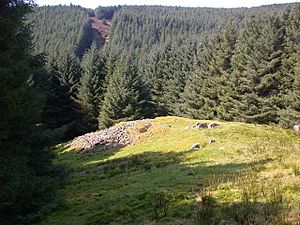Carn Ban, Arran facts for kids

Carn Ban, viewed from the southeast
|
|
| Location | Isle of Arran |
|---|---|
| Coordinates | 55°29′17″N 5°10′53″W / 55.488061°N 5.181281°W |
| Type | Chambered burial tomb |
| History | |
| Periods | Neolithic |
| Site notes | |
| Ownership | Historic Scotland |
| Public access | Yes |
Carn Ban is a very old burial place, called a chambered tomb. It was built a long, long time ago during the Stone Age, a period known as the Neolithic era. You can find it on the beautiful Isle of Arran in Scotland.
Contents
What is Carn Ban?
Carn Ban is a special type of ancient tomb. It is known as a "chambered tomb" because it has rooms or chambers inside. These chambers were used to bury people. The tomb was built during the Neolithic period. This was a time when people started farming and building large stone structures.
Where is Carn Ban Located?
Carn Ban is found in the southern part of the Isle of Arran. To reach it, you need to walk about 4 miles (6.4 kilometers). The tomb sits on a sloping hill. It is in a clearing within a forest. Parts of the site are covered in grass.
What Does Carn Ban Look Like?
Carn Ban is one of the most famous Neolithic long cairns in southwest Scotland. A "cairn" is a pile of stones. This type of tomb is also called a Clyde cairn. It has a unique shape, like a trapezoid. This means it is wider at one end and narrower at the other.
At the wider, northeast end, there is a curved area called a "forecourt." This forecourt leads into a long chamber. The chamber is divided into smaller sections by stone slabs. This design is similar to another tomb called Torrylin Cairn, which is about 3 miles (4.8 kilometers) away. The main chamber of Carn Ban is quite large. It measures about 30 meters (98 feet) long and 18 meters (59 feet) wide.
Discoveries at Carn Ban
Archaeologists explored the tomb in the late 1800s. They were looking for clues about the people who built it. During their dig, they found a few interesting items:
- A small piece of flint. Flint is a type of stone used to make tools.
- A tiny fragment of human bone. This bone was not burned.
- A piece of pitchstone. Pitchstone is a type of volcanic glass.
These finds help us learn about the people who lived here thousands of years ago.
Protecting Carn Ban
Carn Ban is a very important historical site. Because of its importance, it has been named a scheduled ancient monument. This means it is protected by law. Historic Environment Scotland is the organization that looks after it. This helps make sure the tomb is preserved for future generations to learn from.


